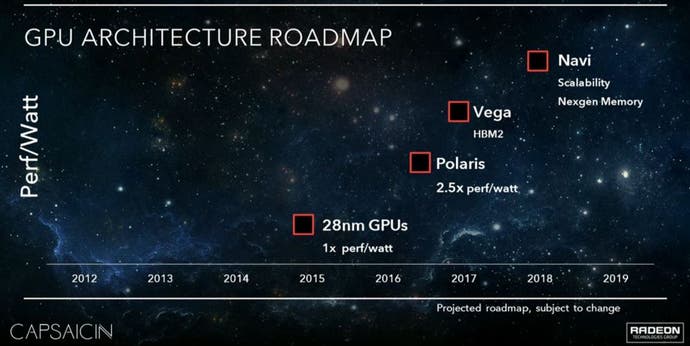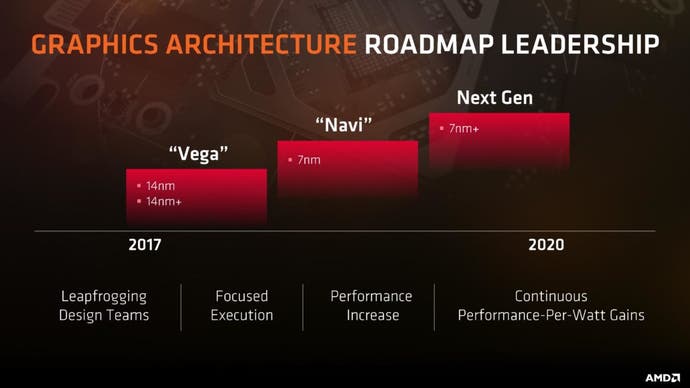PlayStation 5: when can Sony truly deliver a generational leap in power?
And what kind of spec can be realistically delivered?
Rumours and whispers are evolving into stories on major sites, website Semiaccurate is offering top-tier subscriber-level access to what it says are early specs, while unverified leaks and elaborate fakes are starting to hit game forum ResetEra. While PlayStation 5 is indeed in development, firm details on the hardware are obviously limited - we are some way off release, after all. But Sony, and indeed Microsoft, operate within a world of existing technologies available to multiple vendors, and we can offer a good idea of the challenges and possibilities available to the platform holders - not to mention when a new machine may become viable. And there's also a big question we can perhaps address - the extent to which an actual generational leap is possible.
Let's begin with timing. What we do know is that Mark Cerny has once again been hitting the road, talking to developers about their needs for the next-gen PlayStation. But in terms of when an actual retail console is likely to be delivered, there are two crucial technological hurdles that need to be cleared before production of a final unit can begin: that'll be the availability of a smaller, denser process for manufacturing the system's main processor, plus the necessity for newer, faster memory. In both cases, 2019 looks like the earliest possible time a generational leap in console power can be delivered, but other factors - system build cost, for example - may set that back further.
It starts at the transistor level. The 16nm FinFET production process from Taiwanese chip manufacturing giant TSMC is currently used by all of the console manufacturers and while competitors are available (and have been used in the last-gen era), the hot candidate for the process used by PlayStation 5 and the next-gen Xbox will be TSMC's upcoming 7nm FinFET technology. Mobile devices will likely first dibs on the process, and it seems that Huawei may have the first full production run. Typically it requires at least a year for a new process to achieve the kind of efficiency needed to make console production possible, which again makes 2019 the earliest conceivable time for a viable console theoretically capable of delivering a substantial leap in power.
Two competing memory technologies are possible for a new console - HBM and GDDR6. The former is available now, but possibly too expensive for Sony and Microsoft. The latter is a more viable candidate, with mass production due to kick off later this year, just in time for the arrival of Nvidia's new wave of graphics cards. However, again, it will take time for production to ramp up to reach the level where it can service the millions of devices Sony and Microsoft are likely to demand, again meaning that 2019 is going to be the earliest time that a generational leap can be realistically delivered.
AMD is the partner of choice - and Ryzen is potentially huge
It makes sense that Sony will once again partner with AMD for PlayStation 5, and Microsoft's clear messaging on backwards and forwards compatibility also strongly suggests that it's AMD that will provide the central processor for the next-gen Xbox. Again, it's likely that both firms will integrate both CPU and GPU components into a single chip - it keeps costs low and it makes the process of future 'slim' models easier to realise. While Mark Cerny has previously told us about how Sony believes in the console generation, suggesting a clean break between machines, the concept of the platform holder delivering an x86 machine with AMD Radeon graphics tech which doesn't support backwards compatibility seems inconceivable at this point. Cerny expressed concern about CPU compatibility - even between x86 devices - but to put it simply, the firm won't want to leave its current 70m+ userbase behind, especially in light of Microsoft's firm commitment in this area.
So the question is this: what kind of SoC (system on chip) could be delivered in the 2019/2020 timeframe? Well, we know the basic roadmap of AMD technologies that Sony and Microsoft have access to, and we've got a pretty good idea of how 7nmFF chip fabrication scales down compared to the current 16nmFF process. This allows us to fill in some of the blanks, but it's also important to stress that there are a number of huge unknowns - those roadmaps only go so far.
First of all, let's talk CPU technology, where we should expect nothing short of a revelatory boost over the existing consoles. AMD has successfully grafted its Ryzen CPU tech into a desktop 'APU', the closest equivalent in the PC space to the processors used in the consoles. And the fascinating takeaway from this is that a single Ryzen CCX (or core complex) at 7nm should occupy around the same equivalent silicon area as a Jaguar cluster in the existing consoles at 16nm. This opens the door to the inclusion of two CCXs in a prospective next-gen console, meaning that the new machines could deliver eight full cores and 16 threads. Think of this as the console equivalent to AMD's desktop Ryzen 7 line integrated into a console - though almost certainly at lower clock-speeds.
At a stroke, this rebalances the whole console proposition and will change the nature of the games we play. The current-gen machines have been found wanting by the inclusion of what were effectively repurposed x86 cores aimed at the mobile market - it was essentially the only technology available to Microsoft and Sony from the AMD labs at the time when PS4 and Xbox One were being architected. There's little doubt that the next-gen machines will offer desktop CPU-level performance via AMD's Zen core, or further refined versions of it. The potential offered by this level of power in a fixed platform is hugely compelling and could have a fundamental impact on the games we play, with far higher levels of simulation and sophistication.

Graphics and teraflops - and this is where things get tricky
It's pretty easy to speculate that if AMD is the key partner for the next-gen consoles, Sony and Microsoft will leverage the Radeon Technology Group's most advanced graphics hardware - the in-development GPU codenamed 'Navi' - or at the very least, aspects of it. This is where things get tougher to track, because Navi is behind schedule and aside from AMD revealing it uses 'next-gen memory', nothing is known about it. Inclusion of Navi references in a Linux GPU driver suggest that at the very least, it does exist, but beyond that, it's a bit of a mystery.
The signs do point towards Navi still being based on AMD's Graphics Core Next (GCN) technology - which would be highly beneficial in providing easier backwards compatibility for the platform holders. And both Microsoft and Sony should be able to tap into Navi technology even if the desktop parts aren't available - PlayStation 4 Pro utilised features from AMD's current Vega GPUs months ahead of the architecture's debut in the PC space. But the question is whether a true generational leap in graphics power will be possible - and to answer that, it all depends on what you choose as the current baseline: the standard consoles or their enhanced equivalents.
Assuming that a generational leap is defined by a 6x to 8x jump in power, delivering that should be possible if we're looking at the standard PS4 or Xbox One as the reference point. However, it's impossible to deliver that based on current technology if you use PlayStation 4 Pro and especially Xbox One X as the current baseline. If the standard PS4 is our starting point (and to be fair, it is effectively the lead platform in current multi-platform games development), a 6x to 8x leap puts us at 11 to 15 teraflops - which is quite a large window. Obviously, the lower end will be a lot easier to attain than a 15TF monster.
Teraflops in the AMD space are defined as the number of compute units multiplied by 64 - as that's the amount of Radeon shaders per CU. You then multiply that overall shader count by two, as theoretically, two GPU instructions can be processed simultaneously. Multiply that by the clock speed of the processor, then divide by one million to give you the final teraflop figure. Adding some spice to the mix here is that AMD's GCN architecture as we know it may well have a limit of 64 compute units, or 4096 shaders. And realistically, at least four of those CUs (and possibly eight at 7nm) will need to be disabled to salvage as many chips as possible from the production line - something we've seen in all of the existing consoles.

But whether there's a set top-end imposed by the structural limitations of the GCN architecture, or the physical size of the silicon, it's going to be the frequency of the GPU - based heavily on the capabilities of the 7nm process - that's going to be key in getting that teraflop count as high as possible. Typically, frequencies increase from one process to the next, but the speeds attainable at 7nm are unknown right now. Xbox One X's GPU hits 1172MHz at 16nm, but we're going to need a big bump from the next process - around 30 per cent at the minimum.
To hit the bottom end 11TF (6x PS4's 1.84TF), a 60 CU graphics core will need to run around 1500MHz, while a fully enabled 64 CU GPU could run around 100MHz slower. To hit the max 15TF, 60 CUs would require around 1950MHz while 64 would need circa 1850MHz. Suffice to say that if the GCN has a structural limitation at 64 Cus, the higher end looks extremely unlikely to pull off. However, based on the kind of speeds extracted from the GPU core in Xbox One X, 1500MHz or a touch higher on a new process doesn't look unfeasible.
If AMD is able to exceed 64 compute units with its new Navi architecture (scalability is mentioned in an early slide), looking at how the silicon area of the Xbox One X's Scorpio Engine could scale on a 7nmFF process, 80 compute units looks viable, with 72 or 76 active. 1500MHz on such a core would propel you towards the top-end of the 11-15TF window. Something to remember is that the faster a chip runs, the hotter it gets, adding extra expense in terms of the cooling solution.

What about the secret sauce?
Looking back at the standard PlayStation 4 and Xbox One, the graphics hardware in their respective SoCs turned out to be very similar to existing AMD desktop GPU designs - though Sony doubled down on asynchronous compute, while Microsoft introduced instructions for easier backwards compatibility, along with a programmable command processor. However, with the enhanced consoles, we saw much more ambitious, more customised designs. Microsoft made over 40 GPU hardware optimisations, while Sony introduced hardware checkerboarding functionality and Vega-level features like double-rate FP16, or so-called 'rapid packed math'.
Compute units, clock-speeds and teraflops will matter, but we expect both Sony and Microsoft to push the boat out with hardware customisations that reflect their expectations for the generation to come. At this point, it's way too early to speculate with much depth on this, but maybe the recent GDC offered up some small clue as to the way forward with a strong emphasis on hardware-accelerated ray tracing providing some remarkable real-time global illumination.
Now, on the one hand, this may be a blind alley as only Nvidia actually showed off any hardware acceleration support for ray tracing. However, on the other hand, it was revealed that Microsoft is building support for the technology into its DirectX API. It's clearly a big deal and obviously Microsoft is deeply involved, meaning that by extension, the Xbox team will have access to the same technology and may be evaluating it for its new console. Whether even a next-gen GPU could handle this kind of extreme workload remains debatable, though.
Quite how and where Microsoft and Sony target their next-gen hardware all depends on a key question that's not really spec-related at all: specifically, what is 'next-gen' going to be in terms of the experience and what do the platform holders actually want to deliver? And additionally, what is going to separate them? After all, once Microsoft jettisoned its 'TVTVTV' approach for Xbox One, what we were left with essentially was two very similar boxes doing every similar things, with Sony's base PS4 operating with a significant spec advantage.
And finally: pricing
In putting together a projection on the kind of console that could be made and when, we've only really considered one pricing constraint - the size of the main processor and by extension, the amount of graphics and CPU hardware that can fit into it. What we've not considered to anything like the same degree is the cost of crucial surrounding components. On top of that, we can assume that a 7nm chip is more expensive to make than an existing 16nm chip, so silicon area may actually be reduced (and this did happen between both PS4 and Pro, and indeed Xbox One and X).
However, more pertinently, memory prices are increasing dramatically and a move to 12GB, 18GB or 24GB (all are possible on a GDDR6 384-bit memory interface) will have profound cost implications. Similarly, some kind of innovation in storage will be required and the notion of the next-gen consoles moving entirely to a solid-state solution simply piles on the expense. But something innovative is going to be needed here - whether the next wave of machines target 18GB or 24GB of RAM, current laptop hard drive technology just isn't going to cut it in filling up that vast amount of memory. Storage capability, memory bandwidth and capacity are areas where a generational leap will be challenging to attain.
The bottom line, though: a PlayStation 5 due this year simply isn't viable if we're looking for any kind of generational leap. And clearly, the current generation still has much to offer - and practically, it's the time period where both Sony and Microsoft will make some serious money. Drawing the end to this console generation right now simply doesn't make sense - for one, there are no first party games aimed specifically at new hardware that could be released this year.
Q4 2019 is our first viable target for a proper generational leap in console power, but the price of that leap in technology looks daunting. Even in the here and now, the price bubbles in the PC component market are making the high cost of Xbox One X look a lot more attractive. But a relatively large 7nm processor with an Xbox One X-level cooling solution paired with a big upgrade in RAM and some kind of solid-state storage solution? That's a whole new level of expense - and financial viability more than any other factor may well push the arrival of a next-gen PlayStation or Xbox back to 2020.



